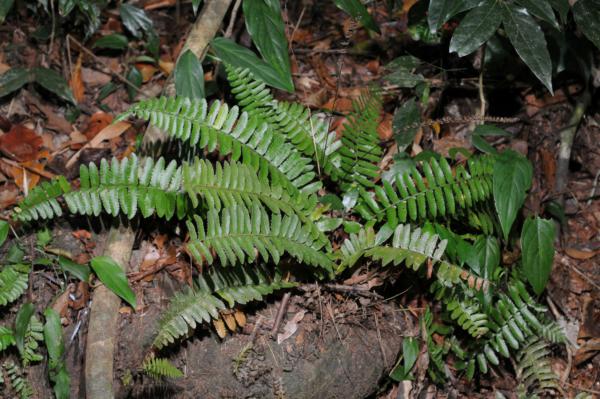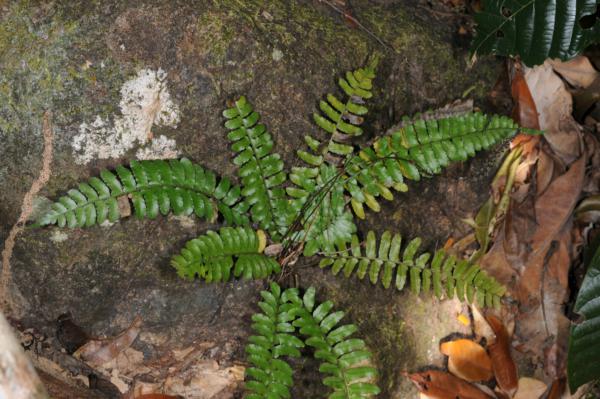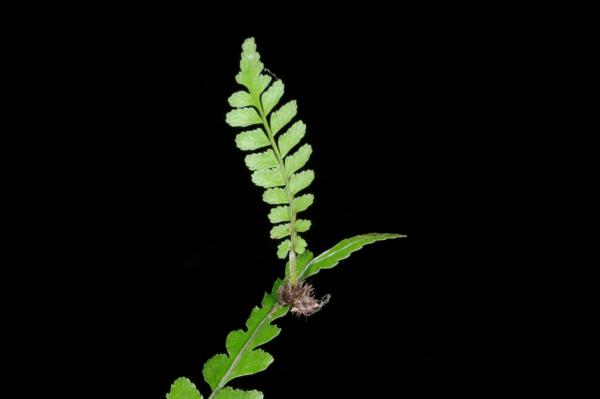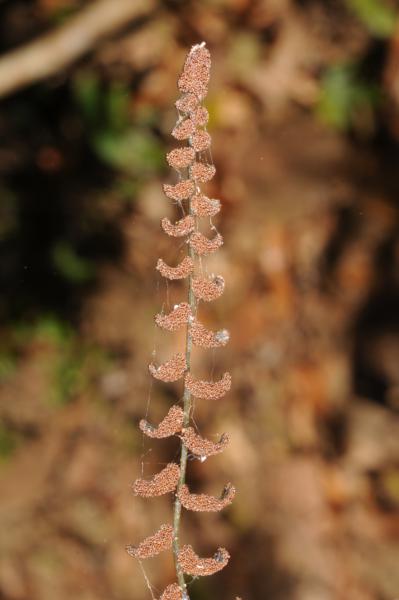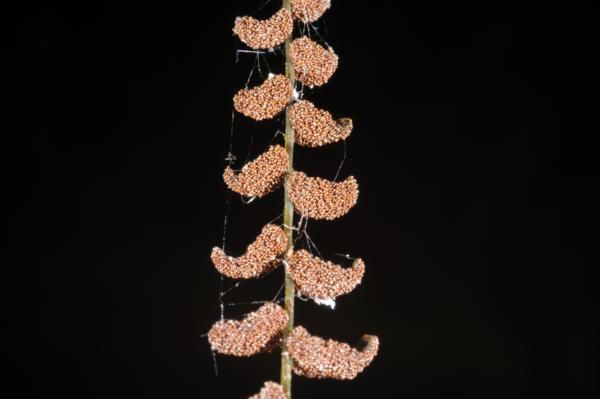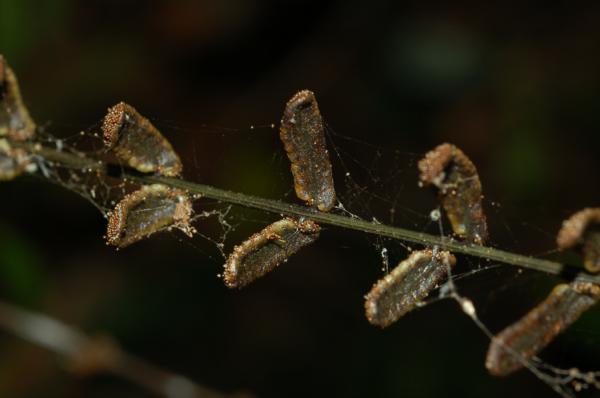
Bolbitis appendiculata (Willd.) K.Iwats.
Family
Dryopteridaceae
Nomenclature
Bolbitis appendiculata (Willd.) K.Iwats., Acta Phytotax. Geobot. 18: 48.1959; Tagawa & K.Iwats., SouthE. Asian Stud. 3(3): 85. 1965; Tagawa & K.Iwats., SouthE. Asian Stud. 5: 90. 1967; Hennipman, Leiden Bot. Ser. 2: 185, f. 49–51. 1977; Hennipman, Fl. Males., Ser. II, Pterid. 1: 322, f. 26b & 27d–f. 1978; Tagawa & K.Iwats., Fl. Thailand 3: 316. 1988; Boonkerd & Pollawatn, Pterid. Thailand: 149, 182. 2000; Newman et al., Checkl. Vasc. Pl. Lao PDR: 27. 2007. – Acrostichum appendiculatum Willd., Sp. Pl. 5: 114. 1810; Hosseus, Beih. Bot. Centr. 28(2): 363. 1911. – Polybotrya appendiculata (Willd.) J.Sm., J. Bot. 4: 150. 1841; Bedd., Handb. Ferns Brit. India: 434, f. 255 1883; Christ, Bot. Tidsskr. 24: 109. 1901; Bonap., Notes Ptérid. 14: 51. 1923. – Egenolfia appendiculata (Willd.) J.Sm., Ferns Brit. For.: 111. 1866; Tardieu & C.Chr., Fl. Indo-Chine 7(2): 426. 1941; Holttum, Rev. Fl. Malaya ed. 1, 2: 459, f. 270. 1955 [‘1954’]; Seidenf., Nat. Hist. Bull. Siam Soc. 19: 87. 1958; Holttum, Dansk Bot. Ark. 20: 29. 1961; Holttum, Dansk Bot. Ark 23: 237. 1965.
Polybotrya helferiana Kunze, Farnkräuter 2: 35. 1849. – Polybotrya appendiculata var. helferiana (Kunze) Christ, Bot. Tidsskr. 24: 109. 1901. – Egenolfia helferiana (Kunze) C.Chr., Contr. U.S. Natl. Herb. 26: 292. 1931; Holttum, Dansk Bot. Ark. 23: 237. 1965.
Polybotrya appendiculata var. marginata (Blume) C.Chr., Bot. Tidsskr. 32: 343. 1916. – Polybotrya marginata Blume, Enum. Pl. Javae: 100. 1828, nom. superfl.
Egenolfia appendiculata var. moniliformis Tardieu & C.Chr., Fl. Indo-Chine 7(2): 427. 1941.
Acrostichum sp. Hosseus, Beih. Bot. Centralbl. 28(2): 363. 1911.
Description
Lithophytic or terrestrial in streambeds. Rhizome creeping; scales light brown or greyish, linear, up to 4 by 0.7 mm. Sterile frond: stipe stramineous, sparsely scaly, 5–13 cm long; lamina lanceolate, acuminate at apex, 10–30 by 3.5–10 cm; rachis scaly beneath, winged at least on upper part, sometimes with bulbils near apex; pinnae 15–25 pairs, basal ones slightly shorter than the next above, middle ones the largest, patent or ascending, stalked, oblong to longer or gradually narrowing from base to apex, rounded to acute at apex, more or less auricled at acroscopic and dimidiate at basiscopic bases, margin shallowly lobed, 1.5–5 by 0.5–1.2 cm, the apical pinna variable in shape and size, usually narrowly subtriangular; veins pinnate, all free; lobes shallow, round, with a distinct tooth at each sinus; papyraceous, deep green, dark when dried. Fertile frond taller: stipe up to 25 cm long; lamina linear-lanceolate, 15–25(–40) by 2–5 cm; rachis wingless, seldom with bulbils; pinnae stalked or subsessile, linear or narrowly oblong or, often, moniliform, patent, straight or a little falcate, 0.7–2.5(–4) cm by (2–)3–5 mm; veins simple, forked or pinnate; sporangia dispersed on the lower surface of pinna or lobes.
Distribution in Thailand
NORTHERN: Chiang Mai, Lampang; NORTH-EASTERN: Phetchabun, Loei, Sakhon Nakhon; EASTERN: Nakhon Ratchasima, Chaiyaphum; SOUTH-WESTERN: Kanchanaburi, Phetchaburi, Prachuap Khiri Khan; SOUTH-EASTERN: Chanthaburi, Trat; PENINSULAR: Chumphon, Ranong, Phangnga, Phuket, Nakhon Si Thammarat, Trang, Satun, Songkhla, Yala.
Distribution in Laos
Champasak, Khammouane.
Distribution in Cambodia
Kampot
Wider Distribution
S China, India to SE Asia generally, throughout Malesia, northwards to Taiwan and the Ryukyus.
Ecology
On muddy rocks near streams or in streambeds in dense forests or in light shade at low or medium altitudes usually below 1200 m alt.
Similar species
Bolbitis hookeriana K.Iwats.
IUCN Conservation Assessment
Least Concern (LC) as listed on the IUCN Red List at http://www.iucnredlist.org/apps/redlist/details/177343/0.
Voucher specimens - Thailand
Middleton et al. 4597, Trat, Ko Chang, Thanmagon Waterfall (E).
Habit
Habit
Bulbil near frond apex
Fertile frond
Fertile pinnae
Fertile pinnae from above
Site hosted by the Royal Botanic Garden Edinburgh. Content managed by Stuart Lindsay, Gardens by the Bay, Singapore and David Middleton, Singapore Botanic Gardens. Last updated 24 January 2012
